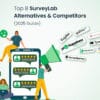For so many years, customer service experts and marketing teams have tried to find out what could be the most accurate methods to understand how customers feel.
The appeal and adequacy of products and services have been surveyed through marketing teams, field preliminaries, interviews, and numerous different techniques. However, with the presence of the digital age, the strategies individuals and organizations use to share and access data have changed.
Sentiment analysis software and text analytics software are programming solutions intended to significantly impact how data is accumulated and perceived.
Discover key insights with piHappiness❤️
Compare Text Analytics and Sentiment Analysis now!
Because of the developing fame of opinion-sharing sites on the Internet, for example, blogs, review sites, and virtual entertainment stages, organizations are presented with new challenges and opportunities to draw in their crowds.
Legitimate execution of analytic solutions ensures a business is prepared for the 21st century.
What is Sentiment Analysis?
Sentiment analysis is the use of cutting-edge computational linguistic techniques to study the subjective meaning of data. This process is particularly useful for analyzing Voice of the Customer (VoC) information. Sentiment analysis is also known as opinion mining and emotion AI.
Because human speech is not always literal, it can be difficult for traditional analytics tools to accurately identify context clues. By utilizing sentiment analysis software, an AI solution, one can find the overall positive, negative, or neutral meaning behind a text’s subtext, greatly improving the quality of the analysis results.
For example, a common analytics tool might include the phrase “I love getting stuck in Monday morning traffic” and would tend to catalog that as a description of positive sentiment. Instead, the artificial intelligence of the sentiment analysis system can recognize that a sentence is sarcastic by reading the subtext of the sentence.
This method of analysis was made possible by the combined efforts of the fields of linguistics and computer science. Recent technological developments permit the formation of refined semantic linguistic software solutions, including regular language handling and the execution of biometrics.
If we talk about sentiment analysis, there is more than one model, and hybrid sentiment analysis strategies can be made by combining two or more methods. Below are examples of sentiment analysis methods:
Rule-Based Sentiment Analysis: This is a simple sentiment analysis solution that does not involve training or machine learning algorithms. Instead, this method works based on a set of rules that decide whether a set of text is positive, negative, or neutral.
Because these rules are known as lexicon, and this strategy is otherwise called lexicon-based sentiment analysis.
Perspective-based sentiment analysis: This type of sentiment analysis looks for data about specific aspects of a product. For example, sentiment analysis based on aspects of a new phone model can gain information about the quality of the display, camera, battery life, storage space, and other aspects that affect the user experience to classify it accordingly.
Emotion Detection Sentiment Analysis: Using a combination of lexicons and machine learning, this method differentiates data based on the sentiment associated with it. Special words and key concepts are selected, and the algorithm decides whether the expressed emotions represent positive or negative sentiment.
Intent analysis: This is an approach to better understand the goals of the customer. For example, one can analyze whether the customer likes the product or not. Customer intent can be tracked to find patterns that can in turn be used to improve marketing and advertising efforts.
The sentiment analysis application has become very popular in the marketing and customer service industries. Sentiment analysis tools make it easy to gather valuable information from client reviews, survey responses, emails, social media content, client support tickets, and some other subjective text data.
What is Text Analytics?
Text analytics is also known as text mining, it is the revelation of new information through the automatic extraction of data from composed assets. Using text analytics, it is easier to gather high-quality information out of any type of text, from books to online reviews.
The text analytics process is facilitated by the following methods:
Information Retrieval (IR): This is Human Computer Interaction (HCI) that occurs when a machine is used to search for information. Retrieved data can come from a variety of sources, and searches can be based on full-text information, metadata, or different sorts of content-based indexing.
Data Extraction (DE): This undertaking naturally removes and makes organized data from unstructured or semi-organized information sources. Collected information may come from machine-readable documents and other forms of multimedia.
Lexical analysis: Lexical analysis is also known as tokenization, it’s a process that relegates importance to a sequence of characters by making a progression of tokens. These tokens are strings of code that can be attached to data and classified.
Pattern Recognition: Starting from statistics and engineering, modern pattern recognition uses machine learning algorithms to recognize and highlight patterns in text or speech. Pattern recognition systems, which are typically optimized with training data, learn and improve as they are used.
Tagging & Annotation: A “tag” is an index term. It can be assigned to a fragment of data. It is a form of metadata that can be used to describe something and make it available for easy retrieval in the future. Information can also be annotated, allowing the person using the software to add their own comments.
Data mining: It is a process that extracts patterns in data sets, irrespective of their size and complexity, using machine learning, statistics, and database systems. Data mining methods empower automatic or semi-automatic analysis of a lot of information, which can then be analyzed into pattern recognition solutions.
Visualization of Information: Analyzed data requires a visual approach for any human analysis process to be used.
This is on the grounds that the data being analyzed is abstract, and for people to understand it, software with the capacity to make visual portrayals of it is necessary.
Predictive Analytics: Using a variety of statistical techniques, predictive analytics compares current and past data and creates estimates of future trends. Predictive models can be used to exploit data patterns, allowing companies to identify potential risks and opportunities.
The general goal of text analytics is to turn text data into valuable insights. By structuring data, time and resources that would otherwise be spent on cataloging and analysis could be better spent on more productive tasks. Hence, text analytics has the potential to improve the efficiency of all communication-based operations.
Difference Between Text Analytics and Sentiment Analysis
Identify Different Kinds of Content
Text analytics will show you what is written about the most. You can see what topics are trending, what ideas are commonly associated with the text, and even who generated which topics the most.
But if you apply sentiment analysis to the same content, it will tell you whether the topics are focused positively or negatively. Sentiment analysis can also be applied to non-textual feedback such as video, audio, and images – as someone smiling at you gives you a higher sentiment score than someone shaking their head and shaking their fist in your direction.
Show a Different Kind of Early Warning
Text analytics can provide alerts if there are problems when a new topic appears in your data. For example, if the word “damaged” suddenly hits the feedback loop in your supply chain, you should look into that area immediately.
Sentiment indicators also indicate potential risks. Nevertheless, with the presence of this case, a decreasing sentiment score indicates that some aspect of your business is causing customers to feel negative about you.
Different Understanding of Context
The results of the textual analysis are more direct in nature. For example, if a text analytics process performed on a product leaves the word “broken” then this is a perfect indication that there are problems somewhere in the supply chain. However, text analytics does not understand the difference in the context of the word “broken” in the expressions “my product arrived broken” and “this is a good replacement for the broken product”.
In contrast, sentiment analysis places the emotion behind the text for each specific word. This means that the first sentence in the previous example will be cataloged as negative, while the second will be considered positive. Opinion examination can likewise search for the unbiased sentiment that refers to the product under investigation but does not contain an emotional tone.








